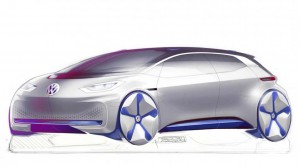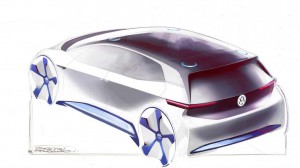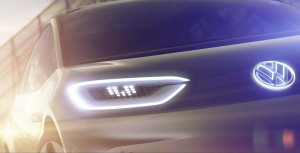
Volkswagen plans to take the covers of several electric vehicles at the Paris Motor Show next month, but released sketches hinting at what's to come.
Volkswagen will come charging into the City of Lights next week, lifting the covers on its newest battery-electric vehicles.
Expected to deliver perhaps 300 miles or more of range, the maker is offering a vague hint of what will be revealed at the biennial Paris Motor Show with a set of sketches. They suggest the unnamed EV will be about the size of a Volkswagen Golf and could be targeted at a variety of electric competitors, anything from the BMW i3 to the upcoming Tesla Model 3, as well as the Chevrolet Bolt set to go sale before the end of this year.
The German maker has traditionally relied on diesels, but in the wake of its emissions scandal it has been rapidly shifting into electric propulsion, as much as a quarter of its sales expected to come from battery-based models a decade from now. The new concept, says the maker, will be “as revolutionary as the Beetle was seven decades ago.”
While VW is saving specifics for its time in the Paris spotlight, it has already given some indication of what’s in the works. Ford one thing, the production version will be based on an all-new platform specifically designed for battery propulsion that will be shared across the vast Volkswagen brand network – Audi among those that will use the architecture.
(Smart plugs in with next-gen Fortwo Electric Drive. For more, Click Here.)
Dubbed MEB, the modular system is similar to the MQB platform used for products like the latest Volkswagen Golf and Audi A4. It is expected to shift away from the current approach used by most manufacturers, stuffing batteries in the trunk or either under or between seats. Instead, it will likely mount the lithium-ion pack under the floor, as Tesla has done with the Model 3 and General Motors with the Chevy Bolt.
That approach has a number of advantages. Among other things, it could make room for more battery cells. Tesla, for example, has been able to offer buyers of the bigger Models S and X a variety of optional packs extending range to more than 300 miles on the sedan. Is that strategy to be echoed by VW? Battery-electric chief Christian Senger said this month that the new VW model would deliver range between 250 and 373 miles. Whether that means different options is yet to be seen.
Mounting the battery pack under the passenger also moves a big hunk of mass closer to the pavement. And lowering the center of gravity should help improve driving dynamics, especially handling. It also freed up more interior space. The maker has said the MEB approach would yield almost 10 extra inches for the passenger compartment.
(Click Here for details about VW moving away from diesels.)
Exactly what the production car will look like is hard to ascertain. The renderings suggest multi-beam LED headlamps anchoring an otherwise grille-less front end. A similar LED style is shown in a more detailed rendering of the taillights.
Inside, the sketches seem to leave out the steering wheel. An oversight? Perhaps, but we know from recent experience that VW is looking into a digital future that includes plenty of high-tech infotainment and safety gear, as well as battery drivetrain technology. It’s highly likely the electric concept would be equipped with an autonomous driving system. But could it go even further, with a fully driverless design?
Ford, of course, is promising to put its first driverless model into production in 2021, so that now seems less of a stretch than it might have even last January, when VW rolled out the BUDD-e, a battery-electric minivan concept, at the Consumer Electronics Show.
(To see more about the Chevy Bolt topping the Tesla Model 3 for range, Click Here.)
Dubbed Project 2025, the tidal wave of new VW battery models will start flowing to market in 2019, when this Golf-sized hatchback goes into production. It is expected to reach showrooms the following year. By 2025, look for 30 new battery cars to be offered by various VW brands.



Oh poor VW did you have to give up your dirty diesels